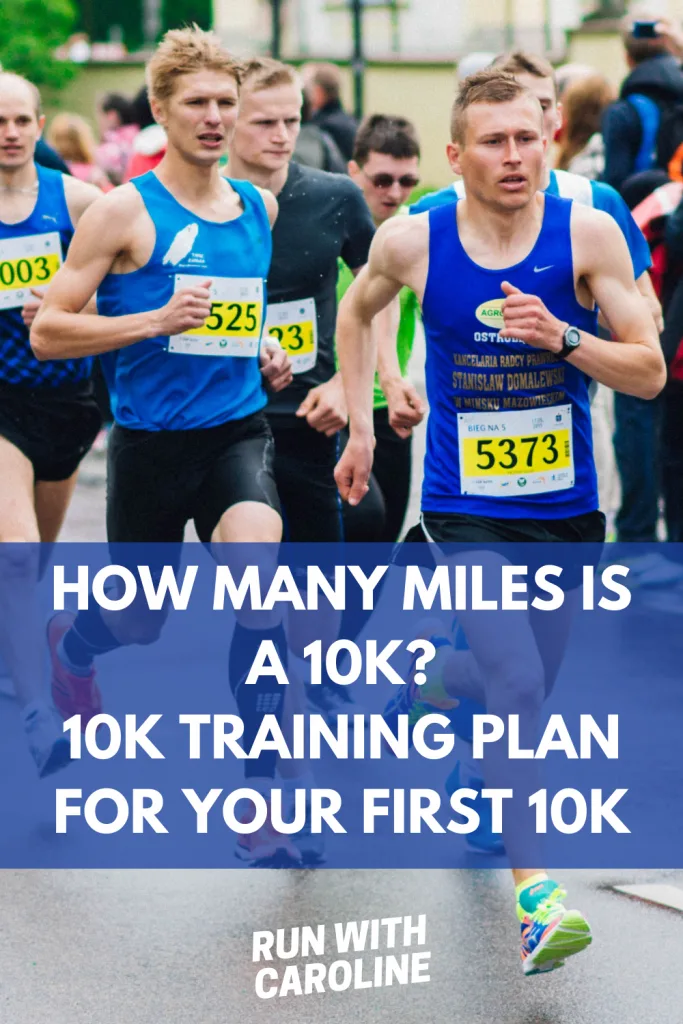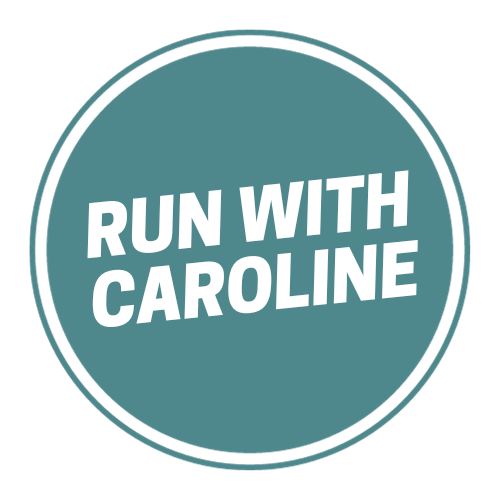The 10k is one of the most popular running distances along with the 5k.
It attracts high levels of participation across the globe.
Its popularity lies in the fact that the 10k distance is long enough to represent a challenge, but short enough to remain accessible to a beginner runner.
If you’re training for your first 10k, you may be wondering how many miles is a 10k?
Many runners go on to run a 10k having completed a 5k.
Whether you’re new to running or have already a few 5k runs under your belt, then this guide will offer tips on training for a 10k.
In this guide we’ll explore:
- 10k in miles: How many miles is a 10k?
- What is the average 10k time by age and gender?
- What is a good 10k time?
- What is the fastest 10k time?
- What is a good pace for a 10k?
- How to train for a 10k
- 10k training tips
Ready?
Let’s get started!

10k in miles: How many miles is a 10k?
A 10k in miles is 6.2 miles.
For comparison, a 5k in miles is 3.1 miles so a 10k is effectively double the distance.
If you’re training for a 10k and you are used to running a 5k, then there are a few things you need to consider.
Firstly, you will need to build up your endurance and stamina to be able to run 6.2 miles on race day.
You’ll also need to ascertain your 10k race pace as you won’t be able to run at your 5k race pace for a 10k – more on that below.
Related: How to run a 5k in under 25 minutes
What is the average 10k time by age and gender?
The average time for a 10k depends on a number of factors, including your age, gender and fitness levels.
Your injury history and the race course terrain can also determine your 10k average time.
If you’re a beginner runner, then a 10k race time of 50 to 70 minutes is an achievable goal.
If you’re able to run a 10k in 45 minutes or less, then this is a huge achievement.
Related: 11 things I wish I’d known before running my first 10k
Average 10k time by age and gender
Here are the average 10k times by age and gender:
| Age | Male | Female |
| 16-19 | 46:36 | 01:00:21 |
| 20-24 | 51:40 | 59:50 |
| 25-29 | 53:31 | 01:02:25 |
| 30-34 | 54:21 | 01:02:31 |
| 35-39 | 54:21 | 01:02:09 |
| 40-44 | 53:31 | 01:02:37 |
| 45-49 | 55:35 | 01:03:27 |
| 50-54 | 56:12 | 01:04:04 |
| 55-59 | 59:00 | 01:07:41 |
| 60-64 | 58:48 | 01:09:51 |
| 65-69 | 01:03:02 | 01:18:57 |
Related: 5k to 10k: 5 of the best 5k to 10k running apps

What is a good 10k time?
Your 10k time will depend on various factors including your age, gender, running experience and fitness levels.
A good 10k time is 49:43 which is the average 10k time across all ages and genders.
This means you have to run 8:00 minutes per mile / 4:58 minutes per km.
Related: The ultimate beginner 10k training plan: Week by week plan + printable
What is the fastest 10k time?
The male 10k world record holder is long distance runner Rhonex Kipruto with a time of 26:24.
This equates to 4:15 minutes per mile / 02:38 kilometres per km.
The female 10k world record holder is former half marathon record holder Joyciline Jepkosgei with a time of 29:43. This equates to 04:47 minutes per mile / 02:58 minutes per km.
Related: How to run a 10k in 45 minutes or less
What is a good pace for a 10k?
Pace is essentially how fast you need to run to achieve your desired race time.
If you’ve set yourself a goal of running 10k in 60 minutes, for example, then your 10k pace needs to be 9.39 minutes per mile or 6 minutes per kilometre.
Use a running pace calculator to determine your pace based on your desired race time and distance.
Below you will find a 10k pace chart to help you determine your baseline pace depending on your goal race time.
10k pace chart
| 10k race pace (mins per mile) | 10k race time |
| 05:00 | 31:04 |
| 06:00 | 37:17 |
| 07:00 | 43:30 |
| 08:00 | 49:43 |
| 09:00 | 55:55 |
| 10:00 | 1:02:08 |
| 11:00 | 1:08:21 |
| 12:00 | 1:14:34 |
Related: What is a good 10k time? Average 10k times by age and gender
How to train for a 10k
The first step when training for a 10k is to find a suitable 10k training plan.
A beginner 10k training plan will typically last between 8 to 10 weeks depending on your running experience and desired race time.
If you’re an intermediate or advanced runner, then you may well be able to train for a 10k in 4 to 6 weeks by using an intermediate 10k training plan.
A well-rounded 10k training plan will include the following runs and workouts:
- 1 to 3 easy runs
- 1 long run
- 1 speed training session
- 1 strength training or cross training session
Easy run
Easy runs are designed to be just that – ‘easy’.
Don’t worry about speed or pace during these runs, as long as you cover the required distance and run at a gentle pace.
You should be able to comfortably hold a conversation when you run. In this plan you will have three easy runs per week.
Long run
The long run is essential to any 10k training plan to help build your endurance and stamina.
Long runs should be run at a slow pace. Don’t be afraid to take walking breaks if you need to. Your goal is to cover the distance.
Speed training
Speed training is a great way to increase your speed and power as a runner.
This type of training is designed to get you running at a faster pace so you feel comfortable running at certain speeds.
Interval training, tempo running, strides and Fartlek training are all forms of speed training that you can include in your training routine.
Strength training
Also known as resistance training, strength training is essential for any runner to improve their strength, improve their running form and economy and reduce their risk of injury.
One of the key benefits of strength training is that it helps to reduce the risk of common running injuries in runners like runner’s knee and IT band syndrome which are the bane of many runners.
Strength training also helps to keep you strong and healthy as a runner.
Cross training
Cross training is essentially adding different types of training into your routine, such as walking, swimming, cycling or yoga.
These exercises are normally aerobic in nature, and can be viewed as ‘active recovery’.
By adding different forms of training, you will add more variety into your plan. Cross training like cycling also helps to build your endurance and stamina as a runner.
Related: 7 of the best running workouts to build endurance, strength and speed

10k training tips
Now you know what goes into training for a 10k, here are 9 tips on how to run a 10k:
#1 Warm up
The warm up is essential before any run, no matter if you’re running a 5k, 10k, half marathon or marathon.
A warm up has two main parts: jogging and dynamic stretching. You may also want to include running form drills in your warm up.
#2 Cool down
The cool down after a run is an important step in the recovery process.
A cool down can help to reduce the risk of injury and reduce muscle soreness after a run.
Aim to include static stretches in your cool down.
#3 Stretch and foam roll
Another integral part of the recovery process is stretching and foam rolling in between your runs.
Whilst stretching increases your flexibility and mobility as a runner, foam rolling has been shown to improve circulation in your muscles.
Check out my guide of the benefits of foam rolling for runners for more information and tips.
#4 Fuel your running
Nutrition is key when it comes to running longer distances like a 10k.
You’ll want to ensure you are fuelling your body in the right way before a run and eating the right foods after a run to aid recovery.
Carbohydrates should be your main source of fuel before a run, whilst protein should be consumed after a run to help with muscle repair.
#5 Stay hydrated
When you’re dehydrated, this can make you feel sluggish on your run. Dehydration can also contribute to that ‘heavy legs’ feeling on a run.
Ensure you’re drinking enough water throughout your training plan and on race day itself.
#6 Wear the right running shoes
A decent pair of running shoes, along with the right running gear, can make or break your race.
After all, you don’t want a pair of running shoes that feel uncomfortable or give you blisters on race day.
Ensure you wear the right pair of running shoes throughout your training and on race day. You can find tips on choosing the right running shoes in my running shoes guide.
#7 Rest and recover
Unfortunately, overtraining is still a common problem in the running community and is caused by not taking adequate amounts of rest of recovery in between runs.
A good training plan will include 1 to 3 rest days.
Ensure you use these rest days – in other words don’t be tempted to run on your rest days – as you will risk burnout and injury.
#8 Perfect your form
Proper running form is all about helping you run in the most efficient way possible in order to improve athletic performance and reduce the risk of injury.
Posture, foot strike and cadence are all elements of running form.
You can find more information on running form in my running form and technique guide.
#9 Join a running group
Running as part of a group is a great way to boost your confidence and running motivation, inspire you to run and make you accountable for your runs.
A running group can also be a great support network.
And you never know – you may also make some new friends in the process!
- 5 things I wish I’d known before returning to running - March 3, 2024
- Running 20 minutes a day: Benefits + how to start - January 27, 2024
- How to run your first 2 hour half marathon - January 16, 2024

ColonelAngus
Thursday 26th of October 2023
Why do females aged 35-39 run faster 10Ks than females aged 25-34?
Also why do males 40-44 years of age run 10Ks at the same pace as males 25-29 yoa, and significantly faster than males 30-39 run 10Ks?
Caroline Geoghegan
Friday 3rd of November 2023
Hi. Thanks for your comment. This is what the data tells us. These times are based on 10,000 runners that ran a 10k race in 2010. More information on the statistics can be found here: http://www.pace-calculator.com/10k-pace-comparison.php
Amy
Sunday 26th of June 2022
With your beginner 10k training plan… where do I fit in speed training?
Caroline Geoghegan
Friday 1st of July 2022
Hi Amy. My beginner 5k training plan doesn't include speed training, but you can include this if you wish if you feel ready. I'd recommend you do speed training before, during or after an easy run or as a standalone session. I wouldn't recommend doing speed training on the day of a long run. Make sure you warm up before doing speed training as it can be quite demanding, so you want to be sure your muscles and joints are warmed up to prevent injury.
Nancy
Thursday 5th of May 2022
I think that your average time chart was cut off. It's missing about 50% of the potential age groups.
Caroline Geoghegan
Saturday 2nd of July 2022
Hi Nancy. Thanks for spotting this. I have now fixed this :)